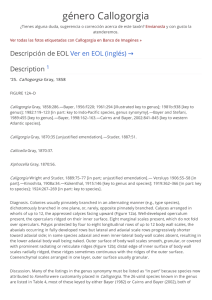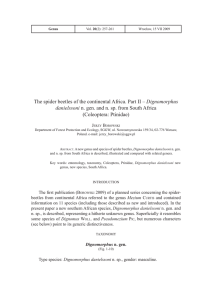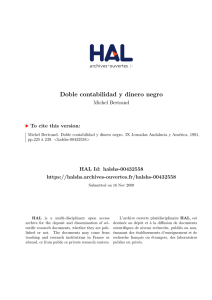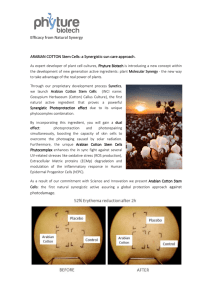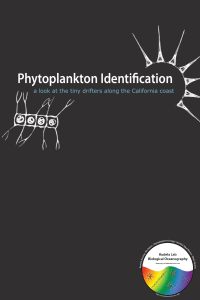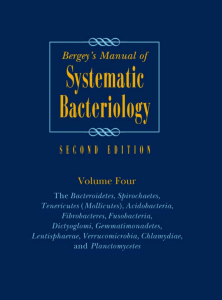Standard PDF - Wiley Online Library
Anuncio
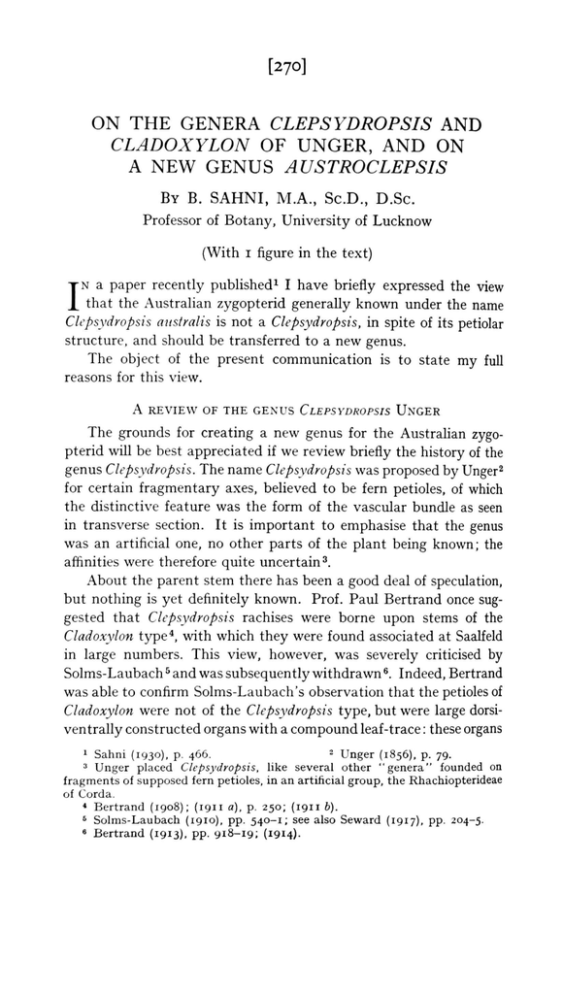
[270]
ON THE GENERA CLEPSYDROPSIS AND
CLADOXYLON OF UNGER, AND ON
A NEW GENUS AUSTROCLEPSIS
BY B. S A H N I ,
M.A., Sc.D., D.Sc.
Professor of Botany, University of Lucknow
(With I figure in the text)
N a paper recently published^ I have briefly expressed the view
that the Australian zygopterid generally known under the name
Clepsydropsis aitstralis is not a Clepsydropsis, in spite of its petiolar
structure, and should be transferred to a new genus.
The object of the present communication is to state my full
reasons for this view.
I
A REVIEW OF THE GENUS CLEPSYDROPSIS U N G E R
The grounds for creating a new genus for the Austrahan zygopterid will be best appreciated if we review briefiy the history of the
genus Clepsydropsis. The name Clepsydropsis was proposed by Unger^
for certain fragmentary axes, believed to be fern petioles, of which
the distinctive feature was the form of the vascular bundle as seen
in transverse section. It is important to emphasise that the genus
was an artificial one, no other parts of the plant being known; the
affinities were therefore quite uncertain*.
About the parent stem there has been a good deal of speculation,
but nothing is yet definitely known. Prof. Paul Bertrand once suggested that Clepsydropsis rachises were borne upon stems of the
Cladoxylon type*, with which they were found associated at Saalfeld
in large numbers. This view, however, was severely criticised by
Solms-Laubach ^ and was subsequently withdrawn ^. Indeed, Bertrand
was able to confirm Solms-Laubach's observation that the petioles of
Cladoxylon were not of the Clepsydropsis type, but were large dorsiventrally constructed organs with a compound leaf-trace: these organs
1 Sahni (1930), p. 466.
- Unger (1856), p. 79.
' Unger placed Clepsydropsis, like several other "genera" founded on
fragments of supposed fern petioles, in an artificial group, the Rhachiopterideae
of Corda.
• Bertrand (1908); (1911 a), p. 250; (1911 b).
' Solms-Laubach (1910), pp. 540-1; see also Seward (1917), pp. 204-5.
• Bertrand (1913), pp. 918-19; (1914).
The Genera Clepsydropsis and Cladoxylon of Unger 271
were found in association with the Cladoxylons and were known under
the provisional name Hierogranima. Organs of the Hierogramma type
were, in fact, found attached to Cladoxylon stems^. Clepsydropsis
was thus again left alone, as a rachis of unknown attribution, and
till now no definite clue as to the parent plant has been found.
It is true that the structure of the foliar bundle had already
earned for this genus an undisputed place among the Zygopterideae,
and this seemed to find support from the recent discovery that in
the Australian zygopterid petioles with a Clepsydropsis-like bundle
were borne upon stems of the well-known Ankyropteris Grayi type2.
This discovery led to the belief that the Thuringian rachises must
also have been borne upon stems of the same kind. Indeed, it was
thought that the problem as to the stem of Clepsydropsis had at last
been solved. However, there was no real ground for referring the
Australian plant to Unger's genus, for, as I have recently shown, the
clepsydroid foliar bundle is by itself no proof of generic identity^.
In the past, of course, the name Clepsydropsis, based on the sole
criterion of the foliar bundle, has been employed rather indiscriminately. Stenzel* employed it as a sub-genus of Corda.'?, Asteroehlaena,
and he grouped under it such diverse plants as the following:
Names as m
Names now generally
Stenzel, 18S9
adopted
Occurrence
Asterochlaena (ClepsyA sterochlaenopsis
W. Siberia
dropsis) kirgisica or
kirgisica
Clepsvdropsis kirgisica
Asterochlaena (ClepsyClepsydropsis
Thuringia
dropsis) antiqua or
antiqua
Clepsydropsis antiqua
A sterochlaena (? ClepsyAsteropteris noveCanada
dropsis) noveboracensis
boracensis
Asterochlaena (ClepsyMetaclepsydropsis
W. Europe
dropsis) duplex
duplex
Age
Probably
Permian
Stem
Known
Lower Carboniferous
Unknown
Upper
Devonian
Carboniferous
Known
Known
More recently I have myself inadvertently referred the Australian
zygopterid to Clepsydropsis, having been misled by the resemblance
in the foliar bundle.
The question is, are we justified in continuing to employ an old
generic name, originally applied to imperfectly known fragments of
obscure affinity, for more completely known plants from distant
regions of the world and of different geological ages, merely because
they all possess a clepsydroid bundle in their leaves?
1 Solms-Laubach (1896), PI. 2, fig. 13; PI. 3, fig. 4; tbid. PI. 2, fig. io. See
also Scott (1923), p. 162, Fig. 64.
2 Osborn (1915); Sahni (1919); Sahni (1928).
2 Sahni (1930), pp. 465-6.
* Stenzel (1889).
272
B, SAHNI
Of the several plants referred by Stenzel to Clepsydropsis, two
{Asteropteris novchoraccnsis and Metaclepsydropsis
duplex) are now
universally recognised as distinct genera. As for the Asteropteris,
Stenzel was himself doubtful about the reference to Unger's genus;
the reference of the other species to Clepsydropsis could scarcely
have been justified even on the petiolar structure alone, and Paul
Bertrand recognised this fact by creating for it the genus Metaclepsydropsis.
The Siberian species once referred to Clepsydropsis was also recently transferred to a new genus, and full reasons for this were given
in my paper already cited. I will now try to show that the use of
the name Clepsydropsis cannot be justified for the Australian plant
any more than for the Siberian.
I have already suggested elsewhere that if we are to avoid confusion the name Clepsydropsis should be restricted to the Thuringian
rachises and to any clepsydroid rachises of unknown attribution
which maybe discovered in the future. Failing this restriction the only
logical course would be to place in the same genus both the Siberian and
the Australian zygopterids, and in fact all newly discovered plants which
may happen to have clepsydroid foliar bundles, regardless of any differences which they may show in their stem and leaf-trace characters. It
seems to me obvious that even with our present imperfect knowledge
of the Zygopterideae a grouping so artificial as this should not be
tolerated.
There can be no doubt that if we had found only the stem and
the pro.ximal part of the leaf-trace, the Australian plant would have
been referred to Ankyropteris, as Mrs Osborn was actually inclined
to do^ It is equally certain that if we knew only the higher parts
of the rachis, where the foliar bundle shows its definitive form, the
plant would be assigned to Clepsvdropsis, and this has actually been
done. But knowing, as we do, that the plant combines an Ankyropteris-like stem with Clepsydropsis-hke petioles, we are on the horns
of a dilemma. Should we give prime importance to the stem and
leaf-trace structure and call the plant an Ankyropteris, or should the
fully formed petiolar bundle, on which the classification of the group
is so largely based, have precedence? A simple e.xpedient which I
once suggested- was to combine the two genera, merging Ankyropteris
in the older genus Clepsydropsis; but it has recently become apparent
to me that such a course would only have caused further confusion.
' See Sahni (1919), pp. S^. ^3^ Sahni (1918), pp. 375-6; (1919), p. S4-
The Genera Clepsydropsis and Cladoxylon of Unger 273
In the history of the genus Clepsydropsis we thus see an instructive example of the way in which reliance upon an isolated
character, namely the Clepsydroid bundle, has again and again led
us into difficulties.
The only alternative seems to be to create a new genus, based
upon a synthesis of the characters. I therefore suggest for the
Australian zygopterid a new generic name Austrodepsis. The plant
would thus be renamed Austrodepsis australis (E. M. Osborn) Sahni
comb.nov.
Austrodepsis Sahni gen.nov.
Diagnosis. Zygopterid ferns combining Clepsydropsis-like, Ankyropteris-like and Tempskya-like characters. The definitive form of the
fohar bundle is identical with that in Clepsydropsis^; the stem stele
corresponds almost exactly with that oiAnk. Grayi or Ank. sca^idens"]
the leaf-trace, both at its origin and in its course through the stem
cortex, also agrees mainly with that of Ankyropteris, except that the
structure is simpler owing to the absence of an adnate axillary
strand 3; the repeatedly forked leaf-bearing stems are bound together
by means of adventitious roots into a Tempskya-like false stem*.
Oceurrenee. Carboniferous of Australia. The only genus of Zygopterideae so far known from the southern hemisphere, with the
possible exception of a Botrychioxylon-like axis epiphytic among its
adventitious roots 5.
Affinities. The nearest known ally is the Siberian genus Asteroehlaenopsis Sahni^. This genus resembles Austroelepsis in having a
Clepsydropsis-like petiolar bundle and a stem stele differentiated into
an oufer and an inner zone; but it differs from the new genus in
having a simple stem, in the numerous rays of the central part of its
stele, in the structure of the leaf-trace both at its origin and during
its course through the stem cortex, and in the slightly abaxial points
of origin of the pinna-traces which thus approach the condition in
Asteroehlaena''. From Ankyropteris the new genus differs in its
Tempskya-like false stem, and especially in the final form of the
foliar bundle, which is that of a typical Clepsydropsis. Clepsydropsis
Unger is known only from its rachises. In their individual structure
^ Sahni (1928), PI. 4, fig. 19.
" Loc. cit. PL 4, fig. 15, etc.
' Loc. cit. PI. 3, fig. 10; PI. 5, figs. 30, 31, 34, 35, etc.
* Loc. cit. PI. I, fig. I.
5 Loc. cit. PL 6, figs 50, 51, and text, p. 25.
* Sahni (1930).
' All these features are fully described and figured in detail in Sahni (1930);
see especially Text-fig. 4 and PI. 50, figs. 6-10; PL 51, figs. 15-25.
PHYT. .X.XXI. 4
19
274
B. SAHNI
these rachises agree generally with the primary petiole of Aiistroclepsis; but they vary in diameter from as little as 4 or 5 mm. to
as much as zy mm. If we ignore certain differences which are
probably due to the exigencies of preservation'^, the rachises of
different sizes, described under several distinct names (C. composita
Ung., C. robustu Ung., C. antiqna Ung., C. aiiliqiia var. exigua
P. Bertrand), readily fall luider one species as rachises of different
orders in a single diffusely branched frond (see Fig. i). As I have
already suggested elsewhere'-, a plant bearing fronds of such a kind
must have differed considerably from any known member of the
Zygopterideae. The mere presence of a clepsydroid bundle in the
leaf need not imply a generic identity of Unger's plant with the
Australian zygopterid any more than with the Siberian. These points
will be further elaborated in a special part at the end of the paper.
The comparison with Tempskya refers only to the habit and, of
course, implies no affinity with the Cretaceous genus. For the present
the Te))ipskya-likv false stem may be included as a diagnostic
character of the genus; it is for the future to show whether it runs
through the whole genus or has only a specific value.
The only known species of the new genus is
Austroclepsis aiistralis (/T. .V. Osbm-)!) Salnii camh.nov.
1915. Preliminary i,)bs(Tvations on an .\ustralian Zvgopteris
E. M. Osborn (1915), p. 727 (no fi,!;urus).
1917. Ankvroptcris australis E. M. Osborn /';; litt., sec Sahni
(1919), p. 82.
1919. An Australian specimen of Clepsvdropsis. Sahni (1910).
1928. Clepsydropsis australis (E. M. Oslxjrn MS.). Sahni (1928).
SPECULATIONS OX THE HABIT A.\D .\FFINITIES OF
The resemblance of Austroelepsis with Clepsydropsis Unger, so
strikingly shown in the foliar bundle, seems to me to express at most
a distant affinity. For reasons presently to be stated, I believe that
the habit and mode of branching of Unger's leaves was very different
from that of both the Siberian and the Australian zygopterids.
In my paper on Asteroelilae>iopsis I hinted at the possibility " that
Unger's Clepsvdropsis rachises, with their varying diameters, represented liranchcs of a large Hierogramma frond, in which case a
' ScL-, on this point, tlir critical observations of Solms-Laubach {1S96),
pp. 25-7, and of liL-rtraiid (iiju), p. 4.
2 Sahni (1930), p. 4OO.
The Genera Clepsydropsis and Cladoxylon of Unger 275
Thuringian Cladoxylon would still be the parent stem of Clepsydropsis"^.
Soon after that paper was sent to the press I made another
European tour and was able to examine some of the other scattered
remnants of the Unger Collection, preserved at Breslau, Lille and
London, and to re-examine the material at Berlin. The most I can
say is that my suspicions on the Clepsydropsis-Cladoxylon question
were strengthened, especially by an examination of some sections in
Prof. Bertrand's laboratory at Lille. If this suspected connection
Fig. I. Clepsydropsis antiqua Unger. Ground plan of foliar bundles showing
probable mode of branching of the frond, as visualised by Paul Bertrand
in his hypothetical form, Eoclepsydropsis. The large and small clepsydroid
bundles, here shown as belonging to different orders of branching in a
single frond, correspond to those of rachises previously described under
the names C. robusta Ung. (I), C. antiqua Ung. (II, III), and C. exigua
P. Bertrand (IV). If, as suggested in the text, these "species" or
"varieties" are only different conditions of C. antiqua Ung. the fronds of
this plant must have differed widely in habit from those of any zygopterid
at present known.
could be established beyond doubt we should have the strongest
possible grounds for removing the Australian species from Unger's
genus. For the present, however, it must be admitted that this proof
is lacking, and until we know better Clepsydropsis antiqua'^ must be
considered entirely by itself. But even then the great variation in
the diameters of these rachises3, and the little that we know of their
' Sahni (1930), p. 466 footnote.
^ Including C. robusta Ung., C. coniposita Ung. and C. exigua P.B., which
are probably only different conditions of C antiqua. See Solms-Laubach
(1896), pp. 25-7; Bertrand (1911), p. 4; Sahni (1919), p. 82.
^ The diameter varies from as little as 4 or 5 mm. to at least 13 mm , the
structure remaining the same. In C. robusta Stenzel records a diameter of as
much as 27 mm.
19-2
276
B. SAHNI
mode of branching, suggests a habit distinct from that of Asteroelilaenopsis and Austroelepsis. The Saalfeld rachises seem to have
belonged to a large diffusely branched frond with ramifications in
two different planes, one perpendicular to the other (see Fig. i)
rather than to a leaf in which a dominant main rachis gave off
minute appendages on the two sides. In such a frond, each branch
rachis must have been supplied at its base by a ring-like strand
which higher up became clepsydroid by tangential flattening and
median constriction. This is clearly suggested by the known facts
that ((7) lateral bundles were nipped off as rings from the ends of the
peripheral loops, and (b) at least in one case (the C. exigua of Bertrand)
the inner ends of the two peripheral loops have been found connecfed
together by a persisting bridge of small tracheids similar to those
lining tlie loops themselves^ Now if we try to visualise the habit
of such a frond it will be found that the branches were in two
rectangular planes, for each annular strand, as it came off, became
flattened in a plane at right angles to that of the parent bundle. If
from our knowledge of the behaviour of the strands we were to
reconstruct the frond in a ground plan, the reconstruction would
agree in a remarkable way with Prof. Bertrand's hypothetical form
Eoelepsvdropsis'-, which he regarded as the Urform of the Zygopterideae.
The unusual habit which this mode of branching would impart
to the frond is easy to imagine. Thus, quite apart from whether
Clepsvdropsis Unger was the foliage of Clado.xylon or not, the available facts seem to support the idea that it was a diffusely branched
frond of very peculiar habit, unlike that of any of the other plants
which have been referred to Clepsvdropsis.
It is considerations such as those set fortli above that make me
hesitate in regarding the Thuringian rachises, without further evidence, as co-generic with any other known plant.
SUMMARY AND CONCLUSIONS
1. Reasons are given for the view that the southern zygopterid
generally known as Clepsvdropsis australis is not a Clepsvdropsis, in
spite of its petiolar structure, but represents a new and distinct
genus. For this the name Austroelepsis has been proposed.
2. Austroelepsis is distinguished from other Zygopterideae by a
1 l i e r t r a n i l (1911), F l . i, ligs. 1 - 5 ; P I . I I . fig. i O ; (1911 u ) . p . 2 1 ,tig. 2 1 ;
s e e S a h n i ( I i ) l 9 ) , ]> ' ^ 4
- liertrand (iyoi)). ]'. 25^, Text-lig. 3 0 .
The Genera Clepsydropsis and Cladoxylon of Unger 277
combination of Clepsydropsis-\ike, Ankyropteris-like and Tempskyalike characters. The petiolar bundle is of the Clepsydropsis type, but
the stem stele and leaf-trace sequence agree with the corresponding
organs in Ankyropteris Grayi or A. scandens, except that the leaftrace has no adnate axillary strand. The repeatedly forked leafbearing axes are bound together by adventitious roots into a
Tempskya-like false stem. The only known species is A. australis
(E. M. Osb.) Sahni comb.nov. With the possible exception of a
slender Botrychioxylon-\ike axis epiphytic among its roots, Austroclepsis is the only genus of Zygopterideae yet recorded from the
southern hemisphere.
3. There is some evidence that in their habit and mode of
branching the Thuringian leaves referred to Clepsydropsis differed
considerably from those of both the Siberian and the Austrahan
zygopterids and, indeed, from any zygopterids at present known.
4. Even if Clepsydropsis Unger was a zygopterid (which on
present evidence seems uncertain) it should not be accepted without
hesitation as co-generic with any other member of that family.
5. To avoid confusion it is desirable that the name Clepsydropsis
be used in the sense of a form genus, that is, it should be reserved
for rachises of unknown attribution containing vascular bundles of
that type. The presence of clepsydroid strands in the leaves is not
by itself a proof that the plants in which they are found belong to
the same natural genus.
ACKNOWLEDGMENTS
I wish to express my sincerest thanks to Dr Crookall (London),
Prof. Soergel (Breslau), Prof. Gothan (Berlin) and Prof. Paul Bertrand
(Lille) for the courteous and liberal manner in which they gave me
access to the material. To Prof. Gothan I am further indebted for
permission to cut fresh sections from some of Unger's blocks, and
for many other kindnesses during my visits to Berlin. Prof. Bertrand
laid me under a deep obligation by sacrificing much of his time in
detailed discussions, both personally and in correspondence, over the
possible attribution of Clepsydropsis to Cladoxylon. It has also been
my privilege, for which I am deeply grateful, to discuss this and
other theoretical points with Prof. A. C. Seward, F.R.S., and Dr D. H.
Scott, F.R.S.
278
B. SAHNI
REFERENCES
BERTRAND, P. Note
Nfiv. 1L>. 1908.
sur les stipes de Clepsydropsis. C.R. Acad. d. Sci. Paris,
Etudes sur la froiuie des Zygoptcridies. Two vols. (text and atlas). Lille.
1909.
Nouvelles remarques sur la fronde des Zygopteridees. Mini. Soc. d'Hist.
Nat. d'Autuii, 25 (annee 191 2). 1-38, Autun. 1911.
(a) L'c-tude anatomique des fougdres anciennes et les probl^mes qu'elle
soul^ve. Progressus rei Botaiiicae. iv Bd. Jena. 1911.
(b) Observations sur les Cladoxylees, Comptes Reiidiis de I'Assoc. FranQ.
pouf rAvaiiceineut des Sciences. Congr^s de Dijon. Paris. 1911.
£tude du stipe de VAsteropteris novehoracensis. Btiide faite a la XII^
session (Ottaiva) du Coiigrds g}ologique international, rcprodiiite du CompteRendu, pp. 909-24. 1913.
£ t a t actuel de nos connaissances sur les genres Cladoxylon et Steloxvlon. Assoc. Franf. pour I'Avancement des Sciences, 43^ Session, Le
Havre, pp. 446 ff. 1914.
OSBORN, E . M. Preliminarj- (jbservatirms on an Australian Zygopteris. British
Assoc. Report (Manchester), pp. 727-8. 1915.
SAHNI, B . On the branching of the Zygopteridean leaf, etc. Annals of Botany,
32, 369-79. 1918.
On an Australian specimen of Clepsydropsis. Annals of Botany, 33,
81-92. 1919.
On Clepsydropsis australis. a zygopterid tree-fern with a Tempskya-Vike
false stem, from the Carboniferous rocks of Australia. Phil. Trans. Roy.
Sue. London, Ser. B, 217, 1-37. 1928.
A sterochlaenopsis, a new genus of zygopterid tree-fern from Western
Siberia. Phil. Trans. Roy. Soc. London, Ser. B, 218, 447—71. 1930.
SCOTT, D . H . Studies on Fossil Botany, 2. 1923.
SEWARD, A . C. Fossil Plants, 3, Cambridge. 1917.
SOLMS-LAUBACH, H . , GRAF EU. t)ber die seinerzeit von Unger beschriebenen
strukturbietenden Pflanzenreste des L nterculni von Saalfeld in Thliringen.
Abh. d. kgl. preuss. geol. Landesanstalt. Neue Eolge, Heft 23, pp. i-ioo.
Berlin. 1896.
Ueber die in den Kalksteinen des Culm in ("ilatzisch-Falkenberg in
Schlesien erhaltenen strukturbietenden Pflanzenreste. I\'. Volkelia refracta, Steloxylon Liidwigii. Zeitschrift ftir Botantk, 8, 52gfl. 1910.
STENZEL, K . G. Die Gattung Tubuaulis Cotta. Mitt, aus dem Min.-Geot.
Museum in Dresden, Heft 8. 1889.
UNGER, F . In Richter u. Linger, Beitrage zur Palaeontologie des Thuringer
Waldes. Dcnkscliriften d. k. Akad. d. Wiss. Wien {Math.-Naturwiss. Kl.), 2.
1856.

